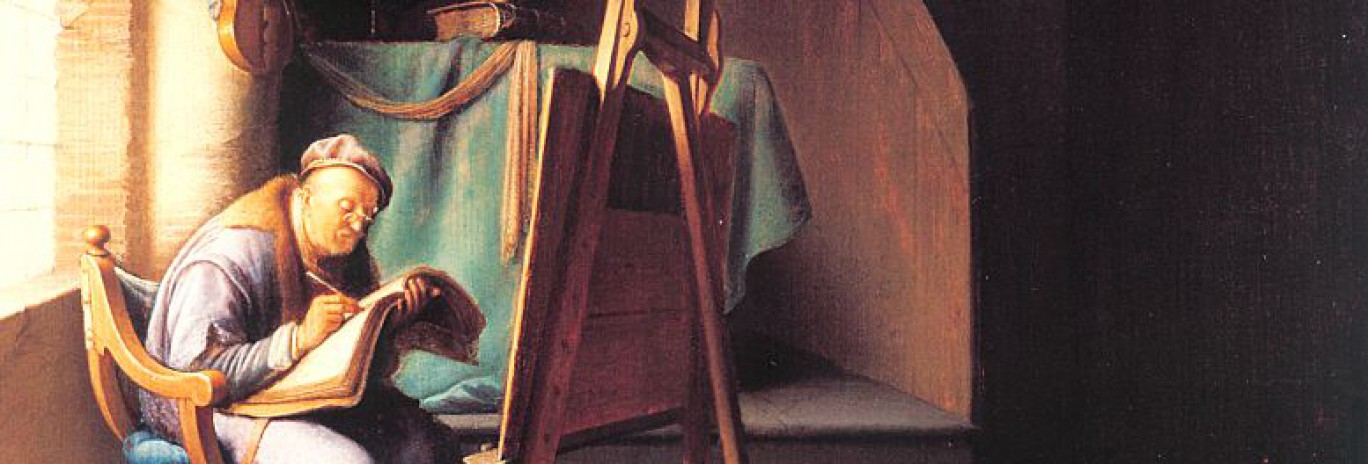Blogs
‘The Art of Dyeing Silk – Workshop on Colour Reproductions of Historical Recipes and Dialogue about Practical Skills
*This blog was originally published on the Textiles, Trade & Taste website on 16/02/2018*
By Art Proaño Gaibor, Ana Serrano and Jenny Boulboullé
On 10 November 2017, the Cultural Heritage Agency of the Netherlands (Rijksdienst voor het Culturele Erfgoed, RCE) organized a pilot workshop on current methodologies of historical reconstructions. Eight participants discussed the importance of studying historical dyeing recipes for their own professional practices and participated in recipe reconstructions of selected dyeing recipes from 1500-1900. The participants produced dyes with historically informed materials and techniques, tested them on silk fabrics, and compared their results with historical textile objects present in museum collections.
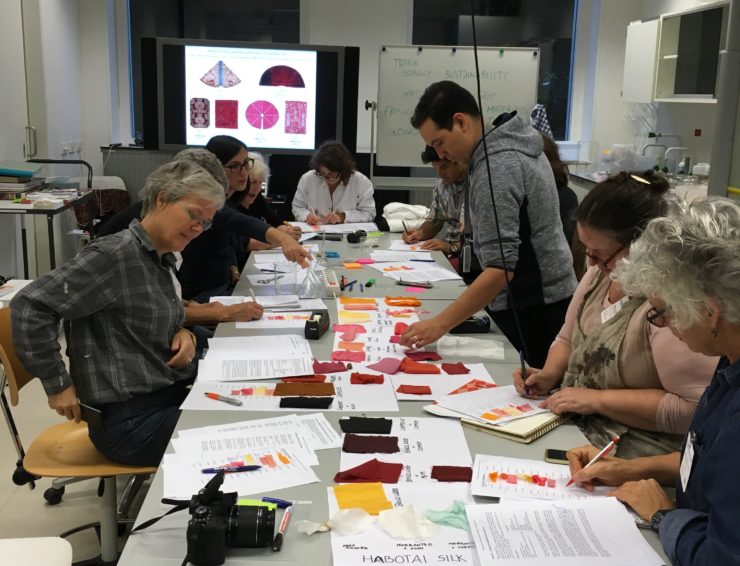
Participants discussing the results and building a reference collection of dyed silk samples.
Colour reproductions
What colour had the faded dress of the queen? How red or how blue was this garment? These kinds of questions are often asked by textile curators and conservators from museum collections. State of the art chemical analyses can give indirect answers to these questions by identifying the dye sources that were used to colour them. But dyeing procedures influence the colours that can be obtained with different dye sources. Further answers about how the textiles originally looked like can be obtained by studying historical dye recipes and dying techniques and by colouring modern fabrics with dyes that are produced by following historical dye procedures. These historical reproductions can then be faded with accelerated artificial methods, in order to mimic the process of natural ageing that museum objects have suffered throughout their lifetime.
This type of research plays nowadays an important role in understanding art technological processes, decay of materials and fading of colours, as well as in defining strategies to preserve historical textiles for future generations. This is the case of the Japanese gown of Prince William III, (c. 1675 – c. 1702) which had almost completely discoloured over time. However, chemical analyses showed the presence of a redwood dyestuff, which indicates that the original colour of the gown could have ranged from deep red to purplish. Can reconstructions help to reimagine its original colour?

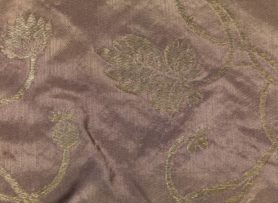
L: Housecoat, collection Rijksmuseum Amsterdam (NG-NM-1106). R: Detail Housecoat, collection Rijksmuseum (NG-NM-1106) – from COSTUME & FASHION (B.M. du Mortier et al., Amsterdam 2016).
Colourful dialogues
Last November, the Cultural Heritage Agency of the Netherlands (RCE) organized, in collaboration with Casper de Groot from the Dutch Textiel Commissie, a one-day pilot workshop at the ‘Ateliergebouw’ in Amsterdam. The Ateliergebouw hosts conservation laboratories of several institutions and has a long tradition in conducting reconstruction research with historically informed artists’ materials and techniques. The workshop aimed to link data found in historical recipes with questions derived from the study of museum objects. In the first part of the workshop Ana Serrano (AFAS-Historical Colours) and Art Proaño Gaibor (RCE) gave an introduction about natural dyes and historical dyeing recipes and discussed the importance of chemical analyses and historical reproductions for textile conservation. They showed examples from museum collections and discussed the importance of historical reconstructions for these case studies. Furthermore, Jenny Boulboullé (University of Utrecht) gave a presentation on artisanal recipe and reconstruction research as it is currently practiced in art history and material culture studies. She also documented the whole workshop in photo and some short video’s and explained the importance of ethnographic documentation methods for reconstruction research. Afterwards, there was time for the eight workshop participants, a group of master dyers and textile professionals, and the organisers to discuss their experiences in reconstructing these recipes and reflect on dyeing as a craft that calls for hands-on experiences with dye stuff and techniques which are rarely documented in our textual sources. For instance, the influence of the type of water, impure mordants, or additives like “alum of lees” (wine fermentation dreg, also known as cream of tartar) for the final colour of dyed silk were debated in relation to dyeing instructions found in important primary art technological source texts, such as the Plictho of Gioanventura Rosetti: Instructions in the Art of the Dyers, from 1548.
In the second part of the workshop, the participants worked in couples with a selection of dyeing recipes from historical sources (as suggested in Further Reading). The recipes contained instructions for dying silk with eight different natural sources of red dye: brazilwood, madder, safflower, annatto, lac dye, American cochineal and kermes. The workshop combined theory and discussion with practical hands-on work and provided thus an enhanced and deepened understanding of the art of dyeing and the technologies and materials involved in centuries-old dye procedures. At the end of the day, participants were able to obtain about 20 different colours on silk, which they then discussed and compared with the colours exhibited by examples of historical objects from museum collections. Moreover, they could build their own reference collection of dyed silk samples.
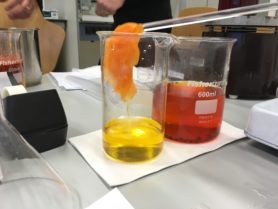
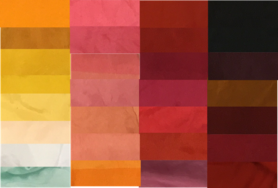
L: Different baths of safflower prepared by the participants. R: Sample of colours obtained in the workshop.
The historically informed reproductions that were produced in the workshop will serve as a well-documented reference collection for further colorants research. They will be artificially aged to gain a better understanding of discoloration processes in textiles and to further our understanding of dyeing techniques and procedures and how they can influence colour fastness and degradation. The organizers of the workshop will present some of these research results in the next workshop “The art of dyeing silk”, as well as at the spring symposium of the Textiel Commissie, dedicated to the theme “Silk”. The workshop “The art of dyeing silk” will be organized again on 5 and 6 of April 2018 at the Ateliergebouw. Check for more information on how to participate here.
For more information about the lecturers/organizers of this workshop: Art Proaño Gaibor (researcher, RCE), Ana Serrano (Dr., researcher, AFAS-Historical Colours) and Jenny Boulboullé (postdoctoral researcher, ERC Artechne Project, University of Utrecht).
FURTHER READING
– Edelstein, S.M., 1969, The Plictho of Gioanventura Rosetti (translation of the 1548 1st edition), The M.I.T. Press, Cambridge.
– De Nie, W.L.J., 1937, De Ontwikkeling der Noord-Nederlandsche Textielververij van de Veertiende tot de Achttiende Eeuw, Leiden, Drukkerij E. IJdo.
– Boyle, 1667, Cambridge MS. containing prescriptions by Drebbel for Kuffler
– Kunckel, 1683-1685, Ars Tinctoria Experimentalis, oder curieuse Wollkommene Endecken der Faerbe-kunst
– Macquer, P. J., 1808, Art de la Teinture en Soie [1763], Paris, Chez Servières, Libraire.
– Anonymous, 1513, TBouck van Wonder, no.16 (Braekman 1986:58-91).
– Hellot, J., 1750, L’Art de la Teinture des Laines, et des Étoffes de Laine, en Grand et Petit Teint, Avec une Instruction ſur les Déboüillis, Paris, La Veuve Pissot, Jean-Thomas Herissant, Pissot fils.

